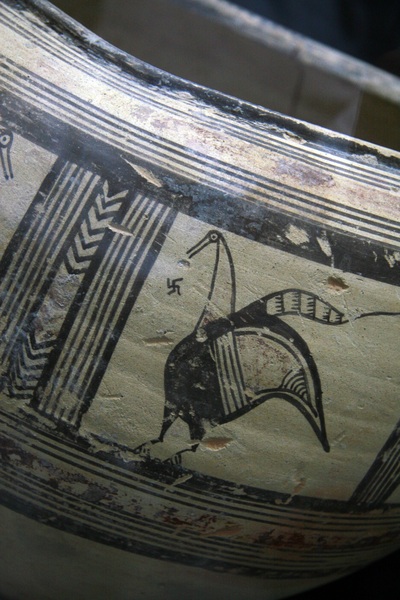Nestled in the East side of the Island of Cyprus lies a treasure trove of ancient artifacts at the Saint Barnabas Monastery Museum, including remarkable ancient Greek pottery that has survived the dramatic history of these lands. These exquisite pieces of pottery offer a window into the artistic and cultural achievements of the ancient Greeks. However, there is one intriguing element that often catches the eye of visitors and researchers alike – the presence of swastika symbols alongside beautiful bird illustrations.
The Swastika Symbol in Ancient Greek Art
The swastika, a symbol that has generated significant curiosity and controversy in modern times, has deep historical roots. While today it is often associated with the horrors of the 20th century, it is important to remember that the swastika has a much older history, dating back thousands of years. In the context of ancient Greek pottery at the Saint Barnabas Monastery Museum, the swastika symbol holds a unique place.
Ancient Greek Usage
The swastika symbol, known as the “gammadion” or “tetragammadion” in ancient Greek, was commonly employed in various forms of Greek art. It appeared on pottery, frescoes, and other artifacts as early as the 8th century BCE. In Greek culture, the swastika was associated with concepts of well-being, prosperity, and good fortune. It was often used to symbolize the sun, life, and eternity.

Variations and Meanings
It’s important to note that the swastika took on various forms in ancient Greece. While the most recognizable version features arms bent at right angles in a clockwise orientation, there were also counterclockwise variants. These different orientations had distinct meanings, with the clockwise swastika representing life and the counterclockwise symbolizing death.
Cultural Exchange
The presence of the swastika on Greek pottery can be attributed to cultural exchange between ancient civilizations. The symbol was not unique to Greece; it appeared in various forms in several ancient cultures, including India, China, and the indigenous peoples of North America. The Greeks likely encountered the swastika through their interactions with these cultures, leading to its incorporation into their art.
The Role of Birds in Ancient Greek Pottery
In the context of the ancient Greek pottery we observed at the Saint Barnabas Monastery Museum, the juxtaposition of swastika symbols alongside bird illustrations adds an intriguing layer of symbolism.
Birds played a significant role in Greek mythology. They were often associated with deities, carrying messages or serving as symbols of divinity. For example, the owl was sacred to Athena, the goddess of wisdom, while the eagle was associated with Zeus, the king of the gods.
The presence of birds on Greek pottery could symbolize various concepts, such as protection, guidance, or the divine. The combination of birds and swastikas may have been intended to convey messages of auspiciousness, protection, and the presence of the divine in everyday life.

The swastika symbol, though controversial in contemporary times, held positive connotations in the context of ancient Greek art. Its presence on these pottery pieces illustrates the rich tapestry of cultural exchange and shared symbolism among ancient civilizations.
As we admire these artifacts, it is essential to remember that symbols can evolve and carry different meanings in different times and contexts. By studying and understanding the historical significance of symbols like the swastika, we can gain a deeper appreciation for the complexities of ancient cultures and their enduring influence on the world today.

In addition to the captivating ancient Greek pottery adorned with swastika symbols and bird illustrations, the Saint Barnabas Monastery Museum houses an array of unique artifacts that shed light on the rich tapestry of history and culture in Northern Cyprus. Among these artifacts are oil lamps adorned with intriguing sexual motives, providing us with a glimpse into the diverse range of artistic expressions and symbolism from antiquity.
They reflect the importance of sexuality and fertility in ancient societies, where such symbolism played a role in rituals and ceremonies aimed at ensuring the prosperity of communities and the continuity of life.




Leave a Reply